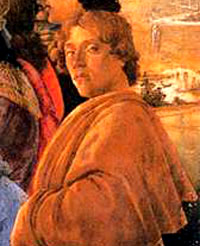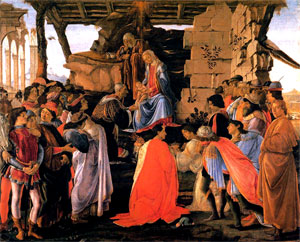Sandro Botticelli: Life and Paintings
Sandro Filipepi, later known as Sandro Botticelli, was born in 1445. He was the pupil of Fra Filippo Lippi, after whose death Sandro was said to be the best master in Florence. From him, Botticelli learned the old beautiful manner of working in tempera, together with the abundant use of gold, two Middle Ages techniques he magnificently applied to the new subjects of the Renaissance art.
Technically, maybe he owed the basis to Fra Filippo. Beyond this, he became himself, as the two had very different temperaments.
There are two famous frescoes painted by Fra Filippo in the choir of the Collegiata at Prato: the “Funeral of St. Stephen” and the “Feast of Herod.” The second shows a fluidity of composition that might suggest also Botticelli’s hand. It is possible that the master designated the pupil to do more work on the Feast of Herod while he was concentrating on the elaborate first fresco.

Botticelli - Self-portrait
From "The Adoration of the Magi"
Sandro Botticelli also learned his trade from studying the more progressive Antonio Pollaiuolo. This is seen in his works executed soon after the Prato frescoes. The Adoration of the Magi, the “Judith,” the “Slain Holophernes,” and the “Fortitude,” painted before he was twenty six, all are showing the real influence under which he was creating. Generally, the dynamic forms of Antonio Pollaìuolo were used in most of the paintings done before Botticelli was thirty six, but in an increasingly independent manner revealing the advance toward his own mastery.
The Adoration of the Magi, painted in 1475, sums up the realistic studies the artist did when he was young. It is an elaborate composition abounding in incidental portraits, fairly outdoing Ghirlandaio on his own ground.
Botticelli renounced to look at Religion as single source of inspiration, as Giotto and his followers did. He sought inspiration in the writings of Dante and Boccaccio, and in his readings of classical works.
Botticelli's most famous pictures had mythological subjects. The Primavera and the Birth of Venus were executed for the head of the younger branch of the family, Lorenzo di Piero Francesco, and adorned his villa of Castello. For him also were designed the beautiful series of illustrations to Dante, testifying to the revival of interest in the great poet. The “Allegory of Spring” was painted in 1482, the “Birth of Venus in 1485.”
His Pallas Taming a Centaur, painted in 1482, is celebrating Lorenzo’s return from his chivalrous expedition to Naples. Esthetically this work can be considered between the “Allegory of Spring” and the “Birth of Venus”. Although summary in execution, it still has the delicate elaborateness of design characteristic to Botticelli.
Curiously enough, he never seems to have executed a portrait of his patron, Lorenzo de' Medici, save in the Adoration of the Magi, where he appears with many members of the Medici family, also with Poliziano and the painter himself; but he painted Giuliano and Lorenzo’s son, Piero, also the Bella Simonetta, Giuliano’s love.
Between 1481-1482, the artist was called by Pope Sixtus IV. to Rome, where he worked on the paintings on the walls of the Sistine Chapel at Vatican. He worked together with Perugino, Rosselli and Ghirlandaio, their work being continued later by Michelangelo, who will decorate the ceiling.
The apparent neglect of Lorenzo and his circle drove him to deeper study of the religious subjects. He somehow deserted the progressive school, and cultivated a revived medievalism.

Botticelli - Adoration of the Magi, c.1475
Uffizi, Florence
The “Calumny of Apelles,” dating from 1494, epitomizes the early and the late Botticelli. It shows all his perfection of line and contour; it outdoes, in the variety and expressiveness of its storied background, even his exuberance of invention.
Later in his life, Botticelli was a follower of Fra Girolamo Savonarola, his works becoming more solemn, even mystic at times. In 1504, he was still elected in the committee formed to choose where Michelangelo's David should be placed. However, with the increasing success of Leonardo, Botticelli's linear style began to be considered obsolete.
Sandro Botticelli, who, in 1481 seemed to be on his way to Italian fame, became the taste of just a few people in Florence. When he died in the middle of May 1510, Fra Bartolommeo was the acknowledged master of the new art, Andrea del Sarto was just rising into popularity, and the young Raphael, who became too great for Florence, was already in Rome.
In Leonardo da Vinci's treatise on painting, Botticelli was the only contemporary mentioned by name. However, he did not enjoy much appreciation later, and Giorgio Vasari remained until recent times the last critic who prized the art of Sandro Botticelli.
After four hundreds years of near-obscurity, Botticelli saw his own Renaissance in the 19th Century, when the Pre-Raphaelites rediscovered him. Poet, painter and Platonist, Botticelli stands out from the other Renaissance artists as the one who most completely mirrors the whole life of his time.